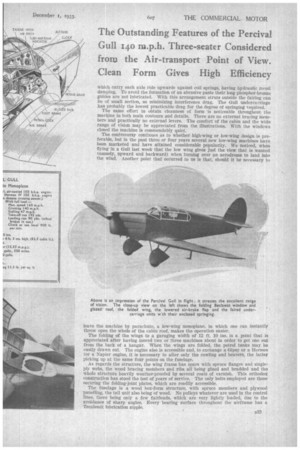A Fast MonopLi.ne
Page 50

Page 51

If you've noticed an error in this article please click here to report it so we can fix it.
for Feeder Services TilE Percival Gull, designed by Mr. E. W. Percival, A.M.I.Ae.E., and marketed by the Percival Aircraft Co., 20, Grosvenor Place, London, SAVA, Is a high-performance feeder-service monoplane, which, with a Napier Javelin 150 b.h.p. engine, will transport a pilot and two passengers, plus 97i lb. of luggage, in saloon comfort at 140 m.p.h. averaging about 15.55 m.p.g. and carrying sufficient petrel for a flight of 500 miles without refuelling. High speed in a commercial machine shows to advantage in several ways. For a given amount of work fewer machines may suffice if their average speed be higher. On a ferry service a fast machine does more trips per day, thus increasing the frequency, and covers more miles per year, thus reducing the overhead cost per trip and per mile... In these early days, when revenue shows little margin over cost of operation, such reduction in overheads may mean all the difference between a loss and a profit. The point was emphasized in this paper in an article on October 6.
Quite apart from economic arguments, there is the outstanding prospect that superior speed reduces the value of the argument that Great Britain's small size places a limitation on air transport. As speeds improve, so will air travel become more attractive and more successful, especially in this country, and the Gull, which cruises at twice the speed of an express train, represents a step in the right direction. For those who do not need quite such high performance, a smaller four-cylindered engine can be fitted. In this case, the cruising speed is 125 m.p.h., and the petrol consumption 18.1 m.p.g. There is also a slight reduction in engine maintenance charges, due to there tieing two fewer cylinders. It may be recalled that the smaller-powered Gull was fast enough to set up for Sir Charles Kingsford Smith, only a few weeks ago, a new record for the England-Australia flight.
Air-transport operators need to have machines of various pay-load capacities, and there is good scope, particularly in regard to private-charter flights, for a fast twopassenger machine such as this, which has comfortable accommodation. An interesting point is that, by removing the upholstery and fittings (30-35 lb.) a useful machine is produced for carrying 4 cwt. of newspapers or mails. • It may be wondered why a retractable undercarriage is not fitted. The weight of retracting gear represents a much greater percentage of the all-up weight and of the pay-load weight on a small machine than on a big machine, and the alternative course has been taken of designing an undercarriage especially for fairing. It will be noticed that there is no spring mechanism outside the _fairing. The sliding cross-heads a32 which carry each axle ride upwards against coil springs, having hydraulic recoil damping. To avoid the formation of an abrasive paste their long phosphor-bronze guides are not lubricated. With this arrangement struts outside the fairing can be of small section, so minimizing interference drag. The Gull undercarriage has probably the lowest practicable drag for the degree of springing required. The same effort to obtain cleanness of form is noticeable throughout the machine in both main contours and details. There are no external bracing members and practically no external levers. The comfort of the cabin and the wide range of vision may be appreciated from the illustrations. With the windows closed the Machine is commendably quiet.
The controversy continues as to whether high-wing or low-wing design is preferable, but in the past three or four years several new low-wing machines have been marketed and have attained considerable popularity. We noticed, when flying in a Gull last week that the low wing gives just the view that is wanted (namely, upward and backward) when turning over an aerodrome to land into the wind. Another point that occurred to us is that, should it be necessary to leave the machine by parachute, a low-wing monoplane, in which one can instantly throw open the whole of the cabin roof, makes the operation easier.
The folding of the wings to a garaging width of 12 ft. 10 ins, is a point that is appreciated after having moved two or three machines about in order to get one out from the back of a hangar. When the wings are folded, the petrol tanks may be easily drawn out. The engine also is accessible and, to exchange a Gipsy or a Hermes for a Napier engine, it is necessary to alter only the cowling and bearers, the latter picking up at the same four points on the fuselage.
As regards the structure, the wing frame has spars with spruce flanges and singleply webs, the wood bracing members and ribs all being glued and bradded and the whole structure heavily weather-proofed by several coats of varnish. This orthodox construction has stood the test of years of service. The only bolts employed are those securing the folding-joint plates, which are readily accessible. The fuselage is a wood box-form structure, with spruce members and plywood panelling, the tail unit also being of wood. No pulleys whatever are used in the control lines, there being only a few fairleads, which are very lightly loaded, due to the avoidance of sharp angles. Every bearing surface throughout the airframe has a Teealemit lubrication nipple.




































































































